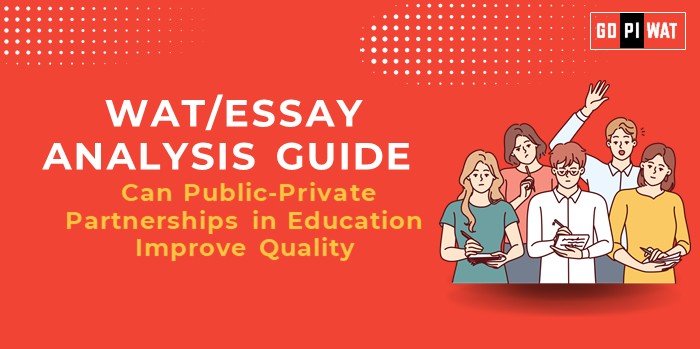📋 Can Public-Private Partnerships in Education Improve Quality?
🌐 WAT/Essay Analysis Guide
💡 Understanding the Topic’s Importance
Public-private partnerships (PPPs) in education represent a collaborative approach that combines innovation from private entities with governance from public institutions. This model aligns with sustainable development goals and operational efficiency, making it a critical discussion point for improving education quality globally.
⏳ Effective Planning and Writing
- 🕒 Time Allocation:
- 📝 Planning: 5 minutes
- ✍️ Writing: 20 minutes
- 🔍 Reviewing: 5 minutes
- 📋 Preparation Tips:
- 📊 Highlight key achievements like improved learning outcomes.
- 💡 Address challenges such as regulatory gaps and equity concerns.
- 🌍 Use global comparisons to strengthen arguments.
📊 Structuring the Essay Body
1️⃣ Introduction:
“Education systems worldwide grapple with challenges of quality and equity. Public-private partnerships emerge as a transformative solution, leveraging combined resources for inclusive growth.”
2️⃣ Body Paragraphs:
🏆 Achievements:
- 📈 Improved Learning Outcomes: Data shows PPP schools outperform traditional public schools in several regions.
- 🏫 Infrastructure Development: Private investment has enhanced facilities, technology, and classroom resources.
- 🌍 Global Success Stories: In the UK, academy schools under PPP frameworks have improved student performance.
⚠️ Challenges:
- 🛑 Equity Concerns: PPPs may prioritize profit-driven models, leading to accessibility issues for marginalized communities.
- 📜 Regulatory Gaps: Inconsistent oversight can compromise quality and accountability.
- 🌐 Global Comparison: Chile’s voucher-based PPP model showed mixed results, raising concerns about widening inequalities.
🚀 Future Outlook:
- 💻 Digital Adoption: Leveraging technology to expand PPP outreach, particularly in rural areas.
- 🛡️ Regulatory Oversight: Implementing frameworks that ensure equity, quality, and transparency in PPP operations.
- 🤝 Collaboration with Ed-Tech: Partnering with educational technology firms to improve access and learning outcomes.
3️⃣ Conclusion:
- ⚖️ Balanced Perspective: “PPPs promise significant improvements but require vigilant implementation to balance equity with innovation.”
- 🌍 Global Example: “From the UK’s academy schools to India’s PPP models, global experiences showcase the potential of public-private collaborations to transform education, provided there is strong oversight and equitable outreach.”
📊 Analyzing Successes and Shortcomings
- ✨ Key Achievements:
- 🚀 Enhanced learning outcomes in PPP-supported schools.
- 🏫 Infrastructure and resource improvements due to private funding.
- ⚠️ Ongoing Challenges:
- 📉 Equity disparities in rural and economically weaker areas.
- 🛠️ Lack of robust regulatory policies leading to accountability concerns.
- 🌍 Global Context:
- 🇬🇧 UK: Academy schools improved student performance through PPP models.
- 🇨🇱 Chile: Mixed results from voucher-based PPPs raise concerns about inequities.
💡 Recommendations for Sustainable Progress
- 🛡️ Policy Frameworks: Develop strong regulations to ensure accountability and equitable access.
- 💰 Subsidies for Equitable Access: Implement financial support for underprivileged communities to benefit from PPP initiatives.
- 💻 Technology Integration: Collaborate with Ed-Tech companies to provide digital resources, especially in rural areas.
📝 Sample Short Essays
🔹 Balanced Perspective:
“Public-private partnerships integrate the strengths of private innovation with public accountability. While PPPs have delivered improved quality in education, ensuring equitable access remains critical to their long-term success.”
🔹 Solution-Oriented:
“By leveraging digital tools and private investment, PPPs can bridge educational gaps. However, strategic policies must address inclusivity to avoid deepening societal divides.”
🔹 Global Comparison:
“From the UK’s academies to India’s PPP schools, global models show that PPPs can significantly elevate education standards, provided strong oversight mechanisms are in place.”


